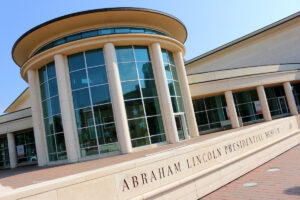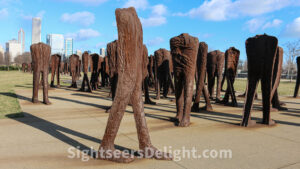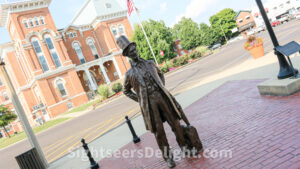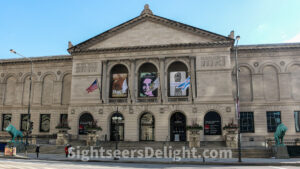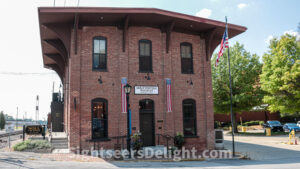Perched on the 94th floor of John Hancock Center is 360 Chicago. The observatory, 1,000 feet above The Magnificent Mile, gives visitors the chance to see four states — Illinois, Indiana, Michigan and Wisconsin — and as far away as 55 miles. On a clear day, anyway. The John Hancock Center is the fourth-tallest building in the city and the seventh-tallest nationwide. To reach the top, guests board elevators that travel 1,800 feet per minute, completing the trip to the 94th floor in a mere 40 seconds.
60611
For more than a decade, the Abraham Lincoln Presidential Library and Museum has provided visitors with a unique insight into the nation’s 16th president. The museum is home to an incredible collection of artifacts, books and documents that help tell the story of the man who presided over the country during one of the most difficult times. The library is not part of the National Archives and Records Administration’s network of presidential libraries. It is administered by the Illinois Historic Preservation Agency.
62701
Agora is an art installation of 106 headless and armless iron sculptures. Polish artist Magdalena Abakanowicz designed the installation, which is located at the south end of Grant Park. In 2006, the Chicago Park District brought the work to Chicago as a permanent loan from the Polish Ministry of Culture. While similar installations have been constructed worldwide, Agora is among the largest.
60605
Sculptor John McClarey of Decatur, Ill., created a statue depicting Lincoln in September 1858 when he arrived in Hillsboro, Ill., while running for Senate. The statue, located near the Montgomery County Courthouse, was unveiled in August 2009.
62049
Founded in 1879 and located in Chicago’s Grant Park, the Art Institute of Chicago is one of the oldest and largest art museums in the country. It is home to more than 300,000 works of art, including a range of iconic and instantly recognizable works of art. Among the works in the museum’s vast collection are Georges Seurat’s A Sunday on La Grande Jatte — 1884, Pablo Picasso’s The Old Guitarist and Edward Hopper’s Nighthawks. Roughly 1.5 million people visit the museum every year. The museum is located in a building built in 1893 for the World’s Columbian Exposition.
60603
The sprawling 2,200-acre Cahokia Mounds complex in Collinsville, Ill., are some of the most impressive Native American mounds in the country. While settlement in the area may date to roughly 1200 BC (during the Late Archaic period), the mounds as they are today were settled circa 600 AD (during the Late Woodland period). The mounds were probably built during the 9th century during the Emergent Mississippian cultural. The settlement has the distinction of being the largest, most influential urban settlement of the Mississippian culture.
62234
The Field Museum of Natural History is one of the largest natural history museums in the world. Known colloquially as The Field Museum, the museum is home to more than 24 million specimens and objects, including gems, meteorites, fossils and cultural artifacts from around the globe. More than 2 million people visit the museum every year. Among the most famous items in the collection are Sue, the largest and most complete Tyrannosaurus rex skeleton currently known, and the infamous Lions of Tsavo.
60605
The Illinois Railway Museum was founded in 1953 when a group of enthusiasts came together to purchase and preserve an Indiana Railroad interurban car, No. 65. The museum was originally named the Illinois Electric Railway Museum, and the museum’s collection includes an impressive collection of electrics, including interurbans, streetcars and L cars.
60180
The Illinois State Museum in Springfield, Illinois, is the state’s official museum of the natural history. Founded in 1877, the museum was originally located inside the sixth Illinois State Capitol but moved as the state government expanded. Between 1961 and 1963, the state built the museum’s current building, the first purpose-built state museum. Exhibits include local fossils, dioramas of Native American life, a collection of glass paperweights and archaeological and ethnographic artifacts.
62706
Abraham Lincoln went to the Great Western Railroad depot on the morning of Feb. 11, 1861, to begin his inaugural journey to Washington D.C. Lincoln and his eldest son, Robert, planned to leave on the 8 a.m. train, while the rest of his family would follow later that day. Lincoln gave a short speech to the group of friends and family who came to see him off. Today, the privately owned depot features Lincoln-related exhibits.
62701

